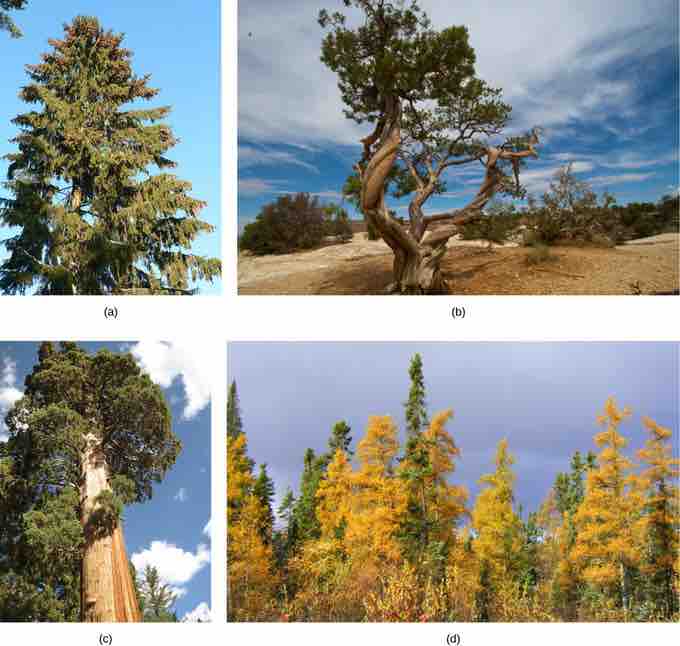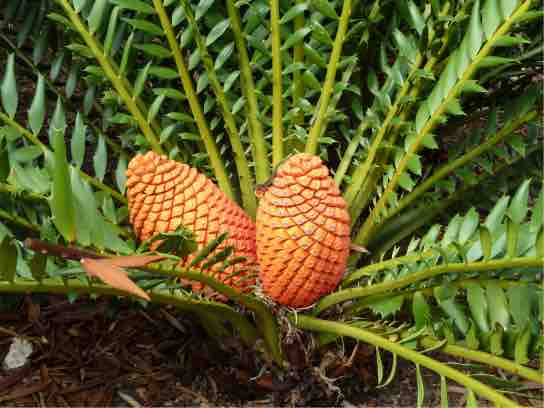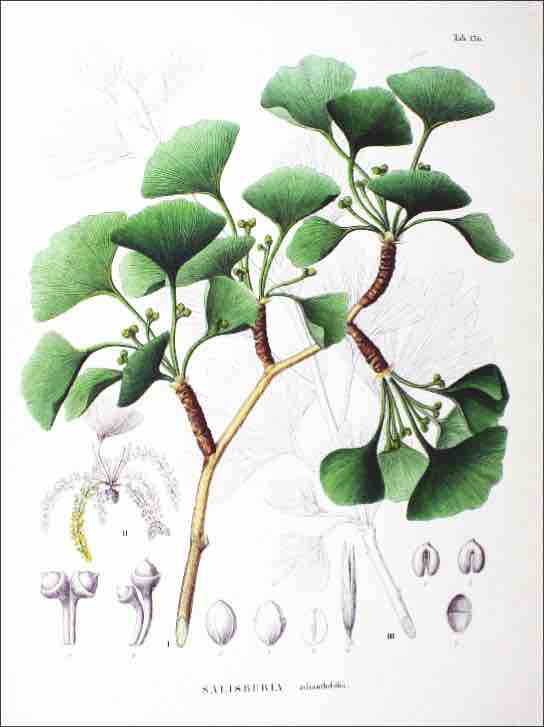Diversity of Gymnosperms
Modern gymnosperms are classified into four phyla. The first three (the Coniferophyta, Cycadophyta, and Gingkophyta) are similar in their production of secondary cambium (cells that generate the vascular system of the trunk or stem and are partially specialized for water transportation) and their pattern of seed development. However, these three phyla are not closely related phylogenetically to each other. The fourth phylum (the Gnetophyta) are considered the closest group to angiosperms because they produce true xylem tissue.
Coniferophytes
Conifers are the dominant phylum of gymnosperms, with the most variety of species . They are typically tall trees that usually bear scale-like or needle-like leaves. Water evaporation from leaves is reduced by their thin shape and the thick cuticle. Snow slides easily off needle-shaped leaves, keeping the load light and decreasing breaking of branches. Adaptations to cold and dry weather explain the predominance of conifers at high altitudes and in cold climates. Conifers include familiar evergreen trees such as pines, spruces, firs, cedars, sequoias, and yews. A few species are deciduous, losing their leaves in fall. The European larch and the tamarack are examples of deciduous conifers. Many coniferous trees are harvested for paper pulp and timber. The wood of conifers is more primitive than the wood of angiosperms; it contains tracheids, but no vessel elements, and is, therefore, referred to as "soft wood."

Diversity of conifers
Conifers are the dominant form of vegetation in cold or arid environments and at high altitudes. Shown here are the (a) evergreen spruce Picea sp., (b) juniper Juniperus sp., (c) sequoia Sequoia Semervirens, which is a deciduous gymnosperm, and (d) the tamarack Larix larcinia. Notice the yellow leaves of the tamarack.
Cycads
Cycads thrive in mild climates. They are often mistaken for palms because of the shape of their large, compound leaves. Cycads bear large cones and may be pollinated by beetles rather than wind, which is unusual for a gymnosperm (). They dominated the landscape during the age of dinosaurs in the Mesozoic, but only a hundred or so species persisted to modern times. Cycads face possible extinction; several species are protected through international conventions. Because of their attractive shape, they are often used as ornamental plants in gardens in the tropics and subtropics.

Cycad leaves
This Encephalartos ferox cycad has large cones and broad, fern-like leaves.
Gingkophytes
The single surviving species of the gingkophytes group is the Gingko biloba . Its fan-shaped leaves, unique among seed plants because they feature a dichotomous venation pattern, turn yellow in autumn and fall from the tree. For centuries, G. biloba was cultivated by Chinese Buddhist monks in monasteries, which ensured its preservation. It is planted in public spaces because it is unusually resistant to pollution. Male and female organs are produced on separate plants. Typically, gardeners plant only male trees because the seeds produced by the female plant have an off-putting smell of rancid butter.

Gingko biloba
Gingko biloba is the only surviving species of the phylum Gingkophyta. This plate from the 1870 book Flora Japonica, Sectio Prima (Tafelband) depicts the leaves and fruit of Gingko biloba, as drawn by Philipp Franz von Siebold and Joseph Gerhard Zuccarini.
Gnetophytes
Gnetophytes are the closest relative to modern angiosperms and include three dissimilar genera of plants: Ephedra, Gnetum, and Welwitschia . Like angiosperms, they have broad leaves. In tropical and subtropical zones, gnetophytes are vines or small shrubs. Ephedra occurs in dry areas of the West Coast of the United States and Mexico. Ephedra's small, scale-like leaves are the source of the compound ephedrine, which is used in medicine as a potent decongestant. Because ephedrine is similar to amphetamines, both in chemical structure and neurological effects, its use is restricted to prescription drugs. Like angiosperms, but unlike other gymnosperms, all gnetophytes possess vessel elements in their xylem.

Gnetophytes
(a) Ephedra viridis, known by the common name Mormon tea, grows on the West Coast of the United States and Mexico. (b) Gnetum gnemon grows in Malaysia. (c) The large Welwitschia mirabilis can be found in the Namibian desert.